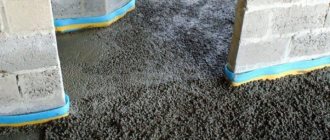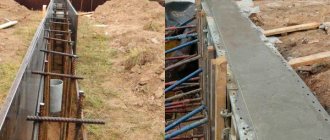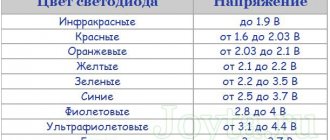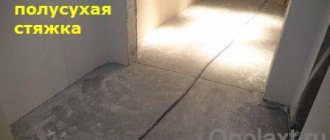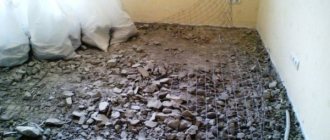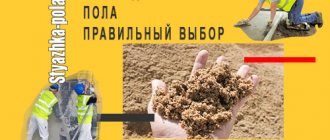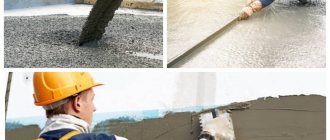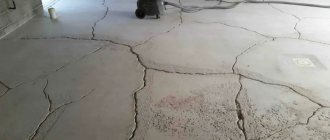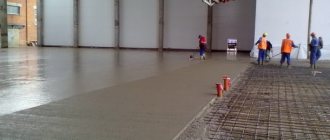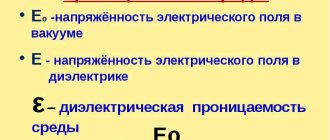Floor screed is the most common base for floor coverings in residential, public, administrative and domestic buildings. According to their design, screeds are divided into screeds on the base, on a dividing (waterproofing) and thermal insulation layer, and prefabricated screeds.
This review will pay special attention to cement-sand screeds and online calculation of incoming components. You can calculate the amount of materials using simple formulas, but a floor screed calculator will greatly simplify this process. In addition to the calculator and methods for determining components, basic recommendations and design features of these types of coatings are given.
Water-cement ratio of cement-sand screed
Cement-sand screeds can be divided into the classic type, widely used in private construction, and professional semi-dry coatings. The main difference between semi-dry screed and classic wet screed is the amount of water. When mixing the solution, it is added almost twice as much as for a wet screed. At the same time, this amount of water is just enough for hydration and gaining brand strength.
Due to the limited water-cement ratio (0.35 - 0.43), it will be difficult to produce a large volume of semi-dry screed using a conventional gravity concrete mixer. Typically, specialized mortar pumps are used for these purposes, which not only forcibly mix the mixture, but also deliver it to the installation site.
If the volumes are small or it is not possible to use bulky equipment, a hand-made semi-dry or wet screed is the way out. The water-cement ratio of a classic screed is 0.48 - 0.55.
The peculiarity of the water-cement ratio is that it is calculated only from the mass of cement. For example, to produce M300 concrete, 100 kg of cement will require 100 × 0.53 = 53 liters of water. But working with the proportions of concrete and mortars, we move on to volumetric indicators. And in this case, 100 kg of cement ≈ 0.07 m³. Multiplying as follows: 0.07 m³ × 0.53 = 0.037 m³ water - you will get an error. How to avoid this is described below in the example of calculating the components of a floor screed.
Which sand concrete is best for floor screed in an apartment?
Currently, sand concrete grades M150 - M500 are produced. The numbers indicate the size of the sand component fraction and the strength of the finished screed.
To the question “Which sand concrete is better for floor screed in an apartment?” experts and experienced builders unanimously answer that this is the M300.
The sand in its composition has a coarse fraction, it is affordable, and the result is simply excellent - the screed is smooth and durable. In addition, sand concrete of this brand is very resistant to intense loads, is not afraid of mechanical damage and high humidity, and is also resistant to high temperatures and changes. M300 is a universal mixture as it is used for both interior and exterior work.
Having learned about the composition of sand concrete, many may assume that this mixture can be prepared independently. Of course, its cost will be an order of magnitude lower, but it is almost impossible to replicate the entire technological process at home. You cannot be sure of the quality of cement, plasticizer and sand, or that the finished coating will be as durable and strong as you expect from it. Therefore, it is better to use ready-made mixtures.
Calculation of sand concrete for floor screed
Equipment for semi-dry screed
It is not at all difficult to calculate how many bags of sand concrete you need to screed the floor yourself.
To find out the consumption of sand concrete per 1 m2 of screed, you first need to measure the area of the room. To do this, it is better to use a tape measure and a laser level to take into account all the differences. Having calculated what quadrature needs to be filled, you can proceed to calculating the amount of material that will be needed.
For example, let's look at how to calculate the consumption of sand concrete per 1 m2 of screed with a thickness of 5 cm.
Let's assume that the area of the room in which the screed will be is 25 m2, and the thickness of the screed is 5 cm.
For 1 m2 of screed 1 cm thick, about 22 kg is required. dry mixture. Now you need to multiply 5 cm by 22 kg. (22*5=110). It turns out that the consumption of sand concrete per 1 m2 of screed 5 cm thick is 110 kg.
Next we multiply 110 kg. per room area - 25 m2 (110*25=2750). It turns out that we will need 2750 kg for the entire area of the room. sand concrete.
One bag of sand concrete weighs 50 kg. To find out the number of bags, divide 2750 kg. for the weight of 1 bag (2750:50=55). Makes 55 bags. — The article was prepared for you by the youbox copywriting exchange (link)
If you have started a renovation, then it is better to entrust the leveling of the floors and the semi-dry screeding of the floor in the apartment to professionals. Experienced staff will help you with this. They will accurately calculate the amount of materials to protect you from unnecessary costs, and will also complete all the work with the highest quality possible. Our craftsmen will perform the screed, strictly adhering to technology and standards, so that it is guaranteed to be strong, even and durable!
Composition of floor screed
Cement-sand floor screed is prepared from the following components:
- Cement. Common brand 400.
- Construction sand of medium coarseness with natural moisture and without clay impurities.
- The water used for mixing the binders of the solution must be clean, potable (from the water supply or from natural water sources).
Additional measures during the manufacture of screeds include:
- Introduction of plasticizers to increase the mobility of concrete and mortar mixtures, accelerate setting and strength gain.
- Screed reinforcement.
When using M400 cement, wet cement-sand screeds are made from a solution consisting of 1 part cement, 3 parts sand and 0.55 parts water. In this case, the resulting compressive strength is at least 150 kgf/cm. For a semi-dry screed with the same proportions of cement and sand, it is necessary to reduce the amount of water to 0.43 parts or less (depending on the moisture content of the sand).
Proportions of components in screeds (in parts) depending on the brand of mortar and cement:
| Brand of solution | Cement brand | Amount of cement | Sand quantity | Water cement ratio for dry/wet |
| M150 | M300 | 1 | 2 | 0,43/0,55 |
| M200 | M300 | 1 | 1 | 0,38/0,48 |
| M150 | M400 | 1 | 3 | 0,43/0,55 |
| M200 | M400 | 1 | 2 | 0,38/0,48 |
| M300 | M300 | 1 | 1 | 0,35/0,4 |
Which one is better to use?
When choosing sand concrete, it is recommended to read the information on the packaging of the material: brand and manufacturer. A cheap, homemade mixture will not be of good quality, since it contains low grade Portland cement. And the high content of chlorine and sulfides causes corrosion of metal elements. After drying, peeling or crumbling of the concrete layer may occur.
Before buying cement powder, you need to decide on its purpose. The solution can be made independently in accordance with the established proportions of the components included in sand concrete, but it will not have the same quality as factory products.
In production, this material is divided into fine-grained (fine-grained sand is used) and coarse-grained (coarse sand). The larger the sand fraction, the higher the grade of the product produced.
often used for plastering facades and walls inside buildings.
Recommendations for using different grades of sand concrete:
- to level wall and ceiling surfaces and seal seams between block building materials, you can use low-grade material - M150;
- composition M200 is suitable for laying bricks or building blocks;
- M300 is used for arranging floors and constructing concrete structures;
- high grade material M400 is used in the construction of bridges.
To ensure the strength of the construction project under construction and increase its operational period, it is recommended to use dry sand concrete compositions characterized by the following qualities:
- homogeneity of the finished solution;
- minimal shrinkage after the coating dries;
- high strength of the material.
All of the above parameters correspond to the composition of the M300 brand, which includes 1 part cement and 3 parts sand. This is a universal building material that is used not only for arranging screeds.
Sand concrete Etalon Stroy is a proven material from a reliable manufacturer.
Affordable cost, acceptable consumption and increased strength of the M300 brand allow it to be used to solve other problems in construction.
Most private and professional developers give preference to this brand of cement powder when purchasing.
Experts also recommend using sand concrete from the following manufacturers:
- "Reference";
- "Stone Flower";
- Brozex.
Their dry mixtures mix well with water and, if the operating requirements are met, do not crack after hardening.
If external installation work is planned, then it is better to use building material. The cement powder from this manufacturer is characterized by increased frost resistance and low aluminum content.
Calculation of screed (number of main components)
For example, let’s calculate the required number of components for a semi-dry floor screed in a room of 20 m². We will use M400 cement. The proportion of cement/sand/water for mortar grade 150 is 1/3/4.3, respectively. The thickness of the screed is 4 cm or 0.04 m (minimum permissible value).
Immediately after production, cement retains the maximum amount of air and therefore weighs less. And during this period, the density of cement grades M400 and M500 is about 1100 kg/m³. During storage and transportation, it is compacted and moistened. So one cubic meter of cement can already weigh 1600 kg.
For calculations we will take the average value of cement - 1300 kg/m³. We also take the weight of one cubic meter of sand = 1600 kg/m³. For water: 1000 l ≈ 1000 kg = 1 m³.
Calculation of floor screed components:
- 20 m² × 0.04 m = 0.8 m³ of mixture is required for the screed.
- First, you need to calculate how many cubic meters are in one part of the solution. It would seem that everything is simple: 1 / (1 + 3 + 0.43). But the problem is the water-cement ratio, which is determined by the weight of the cement. We don’t know the weight yet, but we know the densities of 1300 kg/m³ for cement and 1000 kg/m³ for water. Therefore, at this stage, in order for the calculations to be correct, we will introduce a coefficient of 1.3 for the water-cement ratio. We get: 1 / (1 + 3 + (0.43 × 1.3)) = 1 / 4.559 = 0.219 m³ in one part of the solution.
- For 1 m³ of mortar for semi-dry screed you will need:
0.219 m³ of cement; 0.219 × 3 (multiply by three parts) = 0.658 m³ of sand; 0.219 × 0.559 (water-cement ratio taking into account the coefficient) = 0.123 m³ of water; - Let's convert the results into kilograms and liters: 0.219 m³ × 1300 kg/m³ ≈ 285 kg of cement; 0.658 m³ × 1600 kg/m³ ≈ 1050 kg sand; 0.123 m³ × 1000 kg/m³ ≈ 123 l of water. Knowing the weight of cement, we can check whether we entered the coefficient for the water-cement ratio correctly: 285 × 0.43 ≈ 123 liters of water (everything is correct).
- All that remains is to multiply the obtained data by the required volume (in our case 0.8 m³): 285 kg × 0.8 = 228 kg of cement; 1050 kg × 0.8 = 840 kg sand; 123 l × 0.8 = 98 l of water.
By performing calculations using this method, you will receive the amount of materials required for installing both semi-dry and wet screeds. It is important not to forget about the peculiarities of the water-cement ratio.
Instructions for use
Knowing the characteristics of the etalonstroy building mixture, you can understand whether it is suitable for specific types of work. If you choose this sand concrete, you need to know how to use it and what to follow during the work process.
First you need to prepare the surface of the floors, clean them of dirt and be sure to dry them. When there are cracks and deformations on the surface, they need to be eliminated. Before pouring, be sure to wet the surface to be poured.
Then you can start stirring the solution and pouring the surface to be treated.
It is very simple to prepare the solution. The basic instructions for using the standard are on the bags, so this should not be difficult. You need to pour the dry mixture into a concrete mixer or mixing container with a mixer, then simply pour in the required amount of water and mix the mixture until a homogeneous, plastic consistency is obtained. Water consumption according to the standard is 1.6-2.0 liters per 10 kg of sand concrete.
You need to work with the prepared solution within 2 hours after mixing. After pouring sand concrete, after 48 hours you can check the strength of the poured surface, but it can be finally measured after one month. In the process of gaining strength of sand concrete, it is necessary to comply with the required ambient temperature conditions. If the air is cold, this process will take longer.
Related Posts
- Volumetric weights of materials
- Brick laying mortar
- Floor screed thickness
- How to make a mortar for floor screed, the main proportions of cement and sand per 1 m3
- How long should a floor screed dry?
- Floor screed mortar
- Installation of beacons for floor screed
- Proportions of cement and sand for floor screed
- Leveling the floor according to beacons
- Liquid plasticizer or liquid soap?
- Technology for creating a screed on a wooden floor
- Do-it-yourself dry floor screed: let’s figure out how to do it right
- Step-by-step technology for pouring self-leveling floors
- What is a semi-dry floor screed?
- Fiber fiber for floor screed: semi-dry mixture reinforcement
- Installation of a warm water floor
- How to build a children's sandbox with your own hands
- Screeding the floor yourself: how to properly prepare the floor and how to fill it
- Features of choosing adhesive for ceramic tiles: tips
- Adding liquid glass to concrete. 2021 instructions
- Optimal temperature for heated floors
- Electric heated floor in a private country house: installation features in a wooden and frame house
- Save on concrete
- Grids for reinforcing concrete floor screeds and their varieties
- Cement laitance: what is it, where is it used, how to prepare, consumption
Read with this
- Volumetric weights of materials
- Brick laying mortar
- Floor screed thickness
- How to make a mortar for floor screed, the main proportions of cement and sand per 1 m3
- How long should a floor screed dry?
- Floor screed mortar
- Installation of beacons for floor screed
- Proportions of cement and sand for floor screed
- Leveling the floor according to beacons
- Liquid plasticizer or liquid soap?
Plasticizers for cement-sand mortar
It is impossible to increase the plasticity of mixtures by increasing the amount of water, since a change in the water-cement ratio will inevitably lead to a decrease in the specified strength of the solution, as well as the formation of shrinkage cracks. For these purposes, it is recommended to use special additives - plasticizers, produced in different forms (liquid, powder).
Plasticizers for concrete are divided into:
- Hydrophilic - reacting with water, which is found in all concrete mixtures. As a result of the chemical process, an astringent and fluid composition is formed. Once in the concrete solution, the plasticizer binds water molecules, which turns into a viscous mixture that interacts with cement, crushed stone and sand.
- Hydrophobic and hydrophobizing - during the hardening process, they push water out of the composition. The operating principle is based on saturating the mixture with microscopic air cavities, which in turn increases the insulating properties of the finished structure, removes excess moisture, and reduces the possibility of freezing of the poured solution.
One of the most common modifications of super plasticizers for increasing the mobility of concrete and mortar mixtures, accelerating setting and strength gain is C-3.
Plasticizers
Plasticizer S-3 is available in the following forms: powder and liquid. The product contains sulfonated polycondensates and sodium sulfate.
Being universal, this additive is widely used for:
- Increasing the plasticity of the mixture.
- Increasing frost resistance.
- Improvements in cement hydration.
- Reducing the concentration of air pores.
Consumption of plasticizer S-3:
| Type of plasticizer S-3 | Consumption, kg / 100 kg of dry cement | Application |
| Liquid | 0,6 — 1,2 | moving concrete for the construction of walls and ceilings, pouring floors, installing screeds |
| Dry | 0,2 — 0,4 | |
| Liquid | 1,2 — 2,4 | self-compacting concrete for pouring foundations, monolithic structures, complex reinforced concrete structures |
| Dry | 0,4 — 0,8 |
Procedure for using plasticizer S-3:
- The liquid plasticizer solution is thoroughly mixed and added to water to dissolve.
- Water with a plasticizer is poured into a running concrete mixer. Measure out the required amount of cement and load it into a concrete mixer. Add solid aggregate and bring the solution to readiness.
- When using powdered plasticizer C-3, you must first prepare a 35% aqueous solution of plasticizer (approximately 1 part plasticizer to 2 parts water).
Semi-dry screed from ready-mixes. Sand mixture
All objects where construction or finishing work is carried out have their own limitations, features and production conditions. Today, one of the most popular technologies for constructing screeds is mechanized semi-dry screed , but due to some conditions and difficulties that may arise at the construction site and the approach to it, it is not possible to use the mechanized method and special equipment, including storage and delivery of construction materials by heavy trucks. technology. This is cement in bags and quarry, coarse sand in bulk. To solve such problems, we use the manual method or small-scale mechanization for semi-dry screed using ready-made dry mixtures, sand mixture or sand concrete of a grade not lower than M300.
Floor screed reinforcement
Screed reinforcement is not a mandatory process and is usually performed in the following cases:
- When the screed is laid on a base subject to bending and stretching. An example would be the installation of a multi-layer floor structure, where the screed is located above a heat-insulating layer of mineral wool, polystyrene foam or sound-proofing materials.
- When using backfill (sand, expanded clay, crushed stone) to raise the floor level, it is also recommended to reinforce the screed.
- When it is necessary to strengthen the screed in places of increased load (under stoves, fireplaces, in the garage).
- When a screed thickness of more than 50 mm is performed.
The main materials for reinforcement are:
- Metal reinforcing mesh. With their help, the most durable coating is created. This is due to the presence of a frame capable of distributing loads in screed structures and protecting them from destruction during bending.
- Polymer, fiberglass and composite reinforcing meshes are weaker in tensile strength than metal ones, so they are used for unloaded screeds (floors in apartments and private houses).
- The third common reinforcing component is fiber. Fiber in the form of fibers can be made of metal, polypropylene, basalt fiber or fiberglass. A screed with fiber mixed into the solution protects against cracks and shrinkage, but cannot resist high tensile and bending stresses.
A common type of fiber is propylene fibers of a translucent white hue, having a diameter of 15 - 25 microns. The proportions of its addition to the solution depend on the requirements for the screed:
| Fiber consumption | Characteristics of the screed |
| 300 g per cubic meter m | Minimum allowable consumption. This amount slightly improves the quality of the screed (binding function) and makes it easier to work with the material. |
| 600 g per cubic meter m | The ductility, resistance to moisture penetration, strength and service life of the coating are significantly increased. |
| 800 to 1500 g per cubic meter m | Maximum efficiency is achieved. |
Typically, screeds in houses and apartments are installed on existing reinforced concrete slabs. Such a base does not allow tensile loads to occur, leading to deformations. Accordingly, in this case there is no need for reinforcing reinforcement - the screed without additional inclusions will perfectly cope with its functions.
Methods for calculating the consumption of sand concrete for screed
Screed is an excellent way to level the floor. It helps to obtain an almost perfectly leveled surface, ready for applying the main coating. Thanks to the polymers it contains and self-leveling, sand concrete is one of the best, most durable and long-lasting options as a base for a floor.
Its physical and mechanical properties are very similar to the usual cement screed, but, thanks to various plasticizers and other auxiliary modifying substances, sand concrete is a more advantageous option in terms of technical characteristics. It is more resistant to mechanical and chemical influences, has greater density and frost resistance. The consumption of sand concrete for screed depends on many factors, which we will discuss below.
